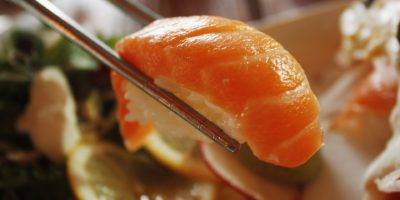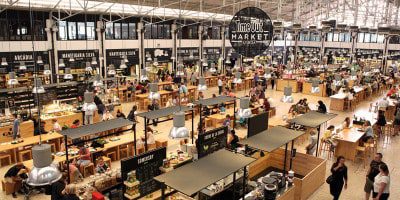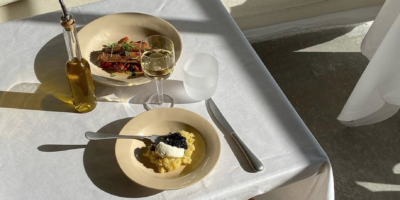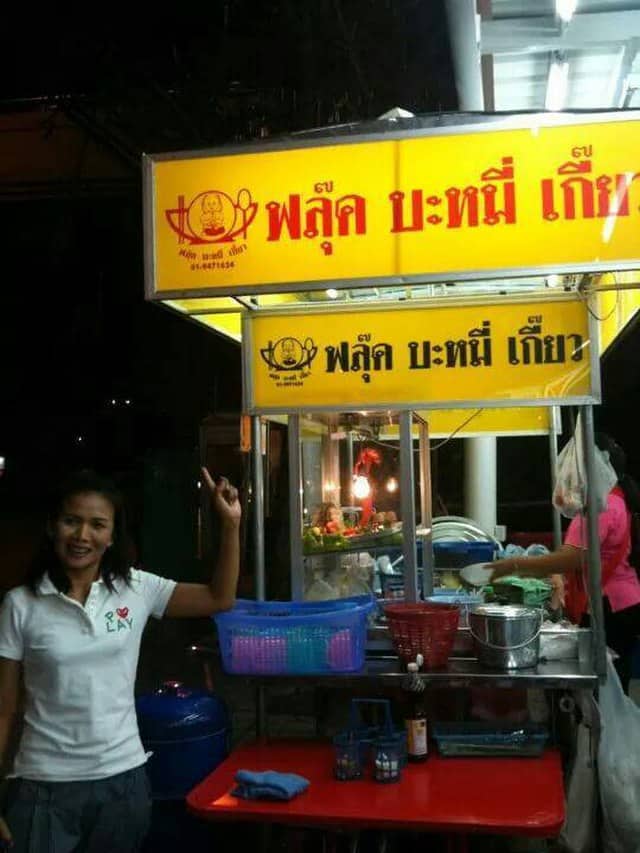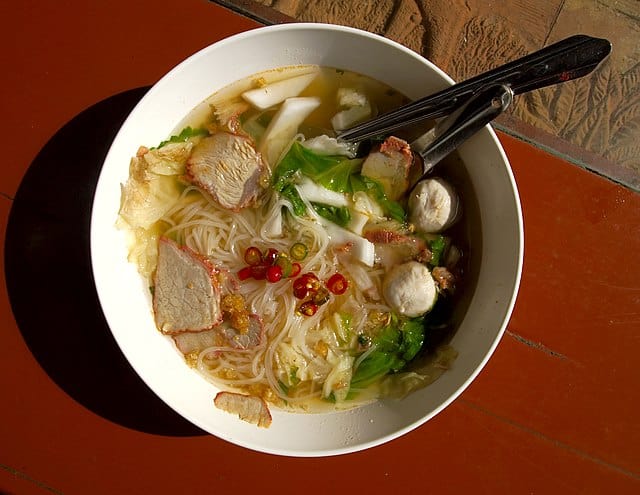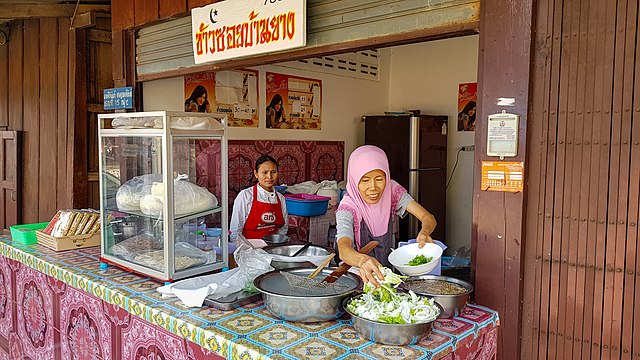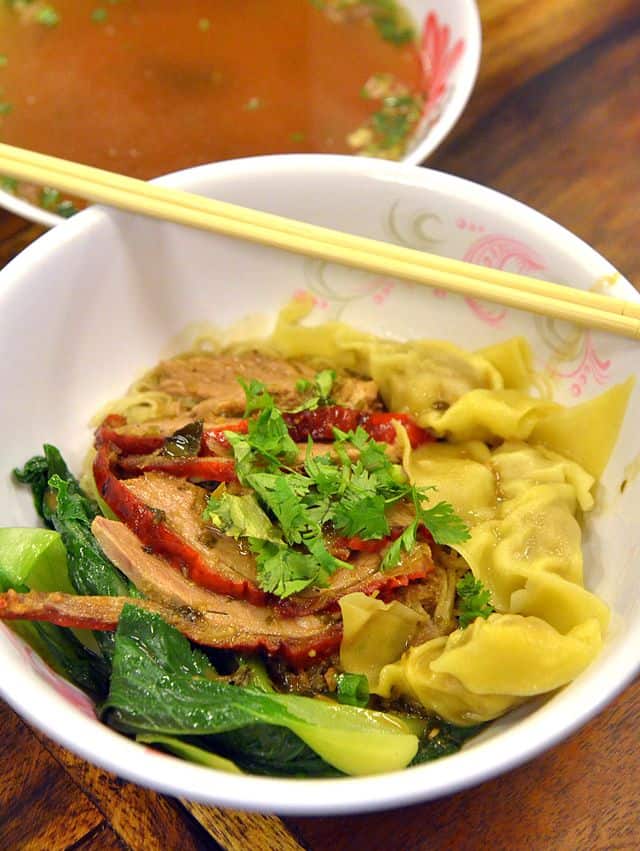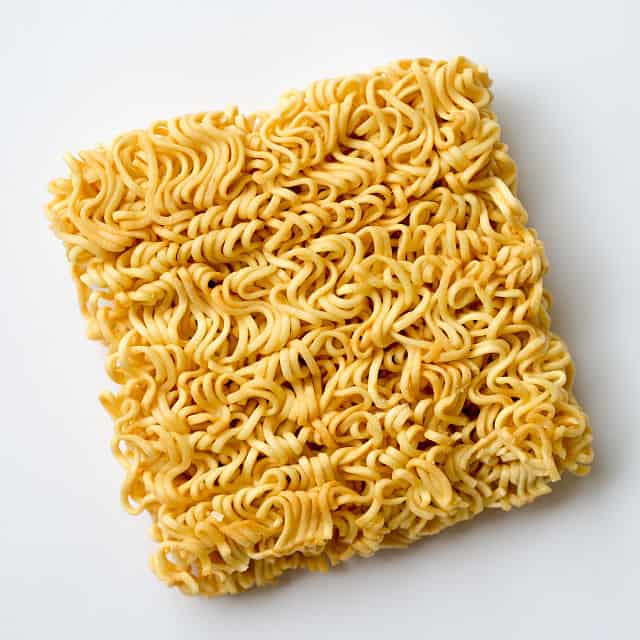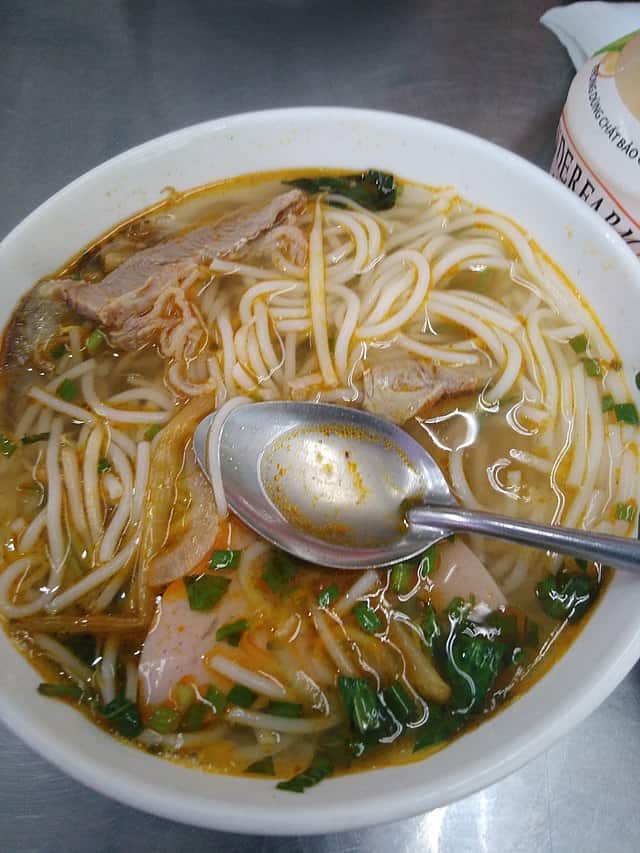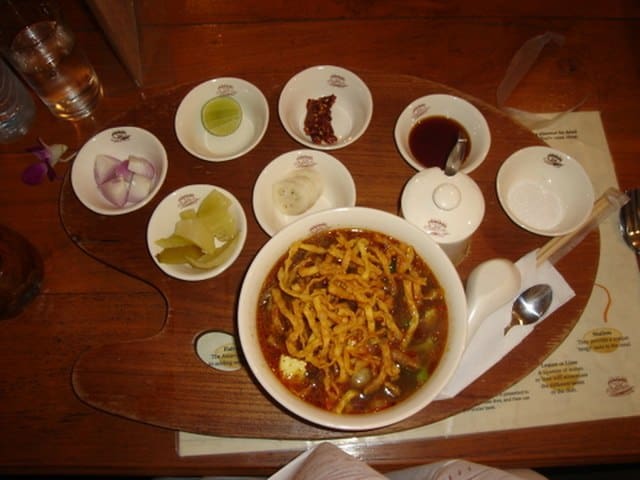A Brief Guide to Thai Street Noodles
If you visit Thailand, and more specifically Bangkok, you will doubtless bear witness to a fair few noodle shops and stands.
You’ll find these pretty much right across the country, but in Bangkok they serve as a staple for many people who consider them delicious, convenient, and cheap.
The noodle stand that is a common sight in the capital can be found anywhere it would seem, and sometimes in fairly diverse locations.
To some people they may look like fairly makeshift set-ups, but they are more than capable of serving the purpose that they are set up for, and the majority of preparation of some of the items involved in the dishes (namely the meat) is done before they even set out with their mobile food stalls.
Depending on where you are in the city, it’s not actually uncommon to find a Thai noodle stand, along with its makeshift seating arrangements (that usually come by way of a few small plastic chairs and tables), outside a fair few 7-Eleven convenience stores, as well as outside parks, bars, and even other restaurants.
There are a few types of noodle dishes sold on the streets of Bangkok that are fairly standard staples for many people. However, when it comes to different variations in terms of the soup, the actual noodles, and their various other additions add-ons and condiments, the list becomes quite extensive.
If you order a standard Thai noodle dish either to eat at the stand from a bowl or to take away in plastic bags (!), you will basically get a bone marrow stock soup with some pork, chicken duck, or some form of meatballs.
A few things to consider with this fairly standard option though, are the type of noodles involved, which basically vary according to the width.
The options of soup and meat varieties can also vary, and you might different options in various regions of the city. For instance some noodle vendors may have a crispy pork option whereas others won’t.
Wherever you may be, you are likely to find the following condiments to add even more flavour to your noodles: sugar, fish sauce, white vinegar and dried chilli flakes.
The simplicity and practicality involved in the running of some of these noodle stands, with their ‘no frills’ approach to eating and dining, makes them a hugely popular street food option for the majority of locals from all walks of life.
However, it can be a little bemusing for visitors who want to try their hand at ordering a bowl of hot, steaming Thai noodles and consuming them from a plastic chair, as there are frequently language barriers involved.
When going the ‘authentic’ route when ordering food in Thailand, many people are likely to find themselves ignored completely when approaching the vendors, especially if standing and queuing politely while waiting for someone to ask you what you would like. Not happening!
So it does help if you know some of the terminology involved in ordering the street noodles, unless you are pretty good at making yourself understood by pointing at a picture on the stand – if indeed it actually has one – and the majority of these vendors don’t carry menus!
So let’s have a closer look at the art of ordering Thai street noodles.
The different noodle types
A couple of the things that you are likely to hear when locals are ordering their noodles in order to distinguish the particular required dish, is the choice of meat, and the choice of the actual noodles, which are largely known as ‘Sen’. This is Thai word for noodle but also translates as ‘line’ in various contexts. You might notice the connection.
So it may even in some cases be as simple as knowing the word for noodle, along with the various words for big (wide), small (thin), and thinner.
If you don’t select the specific noodles you want when ordering, the vendors will likely just give you what they think is the most standard, or they may even ignore you completely!
So let’s first be clear on some of the differences on the noodles available on the majority of Thai street noodle vendors’ stands.
Sen Yai: ‘Yai’ basically means big, and in this instance describes a noodle that tends to be a somewhat wider and flatter variation than the other options.
Sen Lek: ‘Lek’ means small, and hence represents a much thinner variation of noodle.
Sen Mee: This noodle is even thinner than the Sen Lek, and slightly harder in constitution.
Ba-mee: This is basically a yellow, egg noodle (whereas the other previous options are all white).
Ma-ma: This is basically instant noodles. These noodles are quite often used in salads and other Thai dishes.
Oo-en Sen: These are the very thin glass-type noodles, so called due to their similarity in appearance, and are used in many other Thai dishes.
Khanom Jeen: These are the somewhat stickier, fermented rice noodles that are popular with Northern and North-eastern people and dishes. They are usually eaten with a curry-like, fishy gravy.
Noodle Dishes from a Street Vendor
To the uninitiated who may believe that there is only one type of noodle dish, usually involving the dried, packet variety (referred to earlier as ‘ma-ma’), it may come as some surprise that there is a seemingly endless list of variations on the various types of noodles that we just laid out – even on the humble-looking street vendor stalls.
‘Guay Tiew’
This is a fairly general term used to describe noodle dishes, and it can actually take many different forms.
This will mainly be down to the prominent meat being mixed with the noodles such as chicken, pork, duck, fish balls, or on occasion beef (but not often). Then you’ll choose the specific noodle you want (outlined in the previous list), and there you are – Guay Tiew to go.
You’ll be given a set of condiments that may vary slightly but often include the various seasonings along with fresh mint and basil, and sometimes beansprouts.
The meats
Once you know the Thai words for the various meats involved along with the different noodle (sen) options, you’ll be ready to order your Thai street noodles without too much bother.
Although admittedly you might need a little pronunciation practice, even with simple, one-syllable words, as the Thai language is tonal.
Chicken is ‘gai’, pork is ‘moo’, duck is ‘bpet’, and fish (plaa) or meat balls are called ‘luk chin’.
Hence noodles with chicken, and the larger option of noodle, would be ‘guay tiew gai sen yai’.
Fish ball noodles with the smaller variety of noodle would be ‘guay tiew luk chin plaa’.
Simple!
Other Noodle Dishes
So the standard, Guay Tiew style noodles that we’ve outlined so far are usually the variety sold on the hugely popular street vendor stalls. However, there are still yet various other noodle dishes available in Thailand either from street vendors or in restaurants.
Boat Noodle (Guay Tiew Rua)
Here is another very popular choice among local noodle-lovers, and although the noodles come in boat-shaped bowls, apparently the name of the dish originated from the fact it used to be served by vendors plying their wares along the canals from their small wooden boats.
A fairly strong and hearty broth (that traditionally contains animal blood)is the basis, although in some places you can ask for it without blood (mai sai luad). It also contains meat and meat balls, along with the selected noodles of your choice. For some reason this dish is served in very small bowls, although very cheaply at around 10 to 15 baht, and many people order lots of bowls!
Pad Thai
Possibly the most well-known noodle dish to outsiders, Pad Thai is made from a special white noodle called Sen Chan, which originated in the Chantaburi province. The dish contains a sauce combing both sweet and sour flavours, and is made with fresh and dried shrimps along with beansprouts and tofu.
Pad See Ew
Basically this is a standard Thai dish that is comprised of the Sen Yai variety of noodles stir- fried with soy sauce. It commonly includes cabbage and some form of meat or seafood of your choice.
Rad Na
Another local favourite that is largely comprised of large, flat noodles with a congee-style gravy. In terms of origin this is actually more of a Thai Chinese dish (as are most noodle dishes, as it turns out).
The gravy itself is made from cornflour, soy sauce and egg, which accounts for its rather thick consistency. It can be served with chicken, pork or seafood, and often contains kale.
Yum Mama / Yum Oon-sen
Yum means salad in Thai, so these dishes are noodle salads made from ma-ma or oon-sen. They are quite simple, and are usually spicy and sour, and mixed with minced pork or shrimps. You are likely to find stands specialising in yums such as these.
Guay Jub
This is a tasty, savoury and peppery noodle dish that is associated with its own unique noodle which is basically a square sheet noodle that becomes more of a tube shape when boiled. Guay jub is usually pork based and some of the most popular versions include crispy pork, and it often also includes the entrails.
Khanom Jeen
As previously mentioned ‘Khanom jeen’ is a specific kind of noodle originating from the north of the country, if not even further up in China.
You will find plenty of street vendors and restaurants specialising in complete meals using this variety of noodle. There is usually a range of curries and sauces that you eat with it, and it is also quite a popular noodle to use with Thai green curry.
Kao Soi
Here is the signature noodle dish of Northern Thailand, which comes by way of a curried noodle soup made from a combination of coconut milk and red curry paste. The soup is served with 2 types of noodles, namely flat, yellow egg noodles and a handful of crispy noodles to boot.
This dish usually includes either chicken or beef, and is served with a variety of condiments such as fresh lime, pickled cabbage, shallots, and a very fiery paste made from dried chilis.
Yen Ta Fo
This is a slightly bizarre-looking pink-coloured Thai soup comprising various types of noodles served in a hearty pork broth. It is flavoured with pungent, fermented red bean curd which gives the dish its somewhat unique colour. Each bowl contains various condiments like fish balls, seafood, fried tofu, and the deep green morning glory vegetable.
Tom Yum Noodles
This is a dish that can often be confused with probably the most well-known Thai dish of all – ‘Tom Yum Goong’. So this noodle dish is not the same thing at all, but does rather take the same route regarding the flavouring of the popular, spicy and sour soup.
There are two different types of noodles use with this dish as well. The most common version of Tom Yum noodles is actually not that far removed from the regular Guay Tiew noodle soup but seasoned with the various ‘Tom Yum’ components of lime juice, roasted chili flakes, ground pork, and sometimes a few roasted peanuts.
The other (possibly cheaper and more convenient option) is based around the aforementioned, instant ma-ma variety of noodle.
With Or Without Soup
It might sound a little odd, but many noodle dishes can be eaten dry, without any soup being added. This is known as ‘haeng’ (dry) noodles, and if you want to try looking for dry noodle dishes, you consider the Pad Thai or Pad See Ew noodle dishes.
Khao Soi would work equally well, although it would be something of a shame to miss out on the delicious soup that comes with that particular dish. Lad Na could be another ‘dry’ option.
But when it comes down to it, the best Thai street noodles, or at least the ones with the most customers, are the ones selling the soup varieties – so judge for yourself.
Planning a trip to Paris ? Get ready !
These are Amazon’s best-selling travel products that you may need for coming to Paris.
Bookstore
- The best travel book : Rick Steves – Paris 2023 – Learn more here
- Fodor’s Paris 2024 – Learn more here
Travel Gear
- Venture Pal Lightweight Backpack – Learn more here
- Samsonite Winfield 2 28″ Luggage – Learn more here
- Swig Savvy’s Stainless Steel Insulated Water Bottle – Learn more here
Check Amazon’s best-seller list for the most popular travel accessories. We sometimes read this list just to find out what new travel products people are buying.


